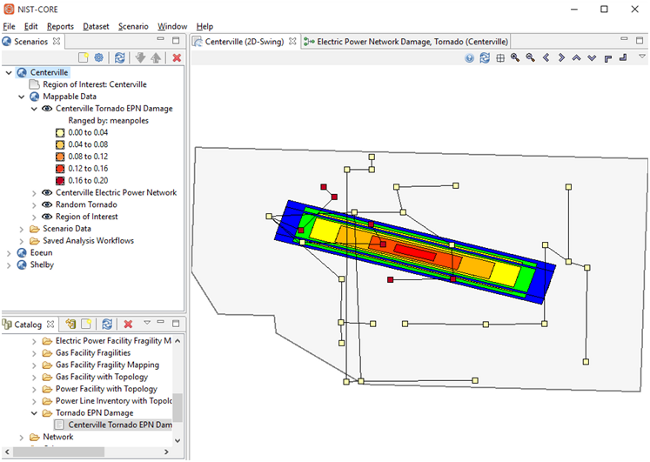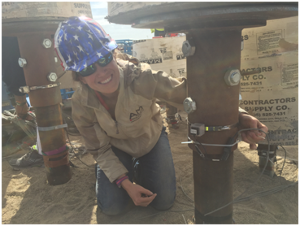Center research programs have been ongoing for approximately 14 months. As part of our program of outreach to educational, professional and administrative personnel interested in community resilience, the Center is organizing its first public information Webinar, held on Thursday, April 28th, 2016, from 9:00 am to 12 noon (MDT). This Webinar will be co-hosted by technical staff from the Center and the National Institute of Standards and Technology. More information about the Webinar can be found later in this Newsletter. The Webinar is designed to provide general information on the Center's research programs and its efforts to provide researchers and community decision-makers with support in making risk-informed decisions. Center researchers will show how models of natural hazards and physical infrastructure are created; how factors that make a community resilient to natural and human-induced hazards are identified; how the complex interactions between physical infrastructure and the socioeconomic systems in a community are modeled; and how risk-informed decision-making might be approached. A demonstration of the first generation decision platform, IN-CORE, the Center's showcase research, is also provided. The Webinar will conclude with a 30-minute period for questions and answers.
As of this writing (mid-April), approximately 300 people have registered for the Webinar, indicating the intense level of current interest in community resilience and the Center's research programs from a diverse audience ranging from university researchers to professional staff from State and Federal government agencies. The Webinar is being recorded on YouTube and will be available to access from the Center's website (resilience.colostate.edu) for those who wish to view it later.
During the last quarter, researchers have been passing algorithms to the Center of Excellence's software developers at the National Center for Supercomputing Applications - each algorithm or module representing one piece of the puzzle that will ultimately become IN-CORE v1.0. Research teams led by H. Mahmoud (CSU) and D. Cox (OSU) developed and programmed algolrithms for Wildland Urban Interface fire spread and Pacific Northwest tsunami inundation, respectively; each model is being implemented in IN-CORE v1.0, and is being linked to physical infrastructure and socio-economic models. Each of the algorithms will be demonstrated during a live Webinar available to the public on April 28, 2016. Additional improvements to existing roadway models (Rice) and a new tornado algorithm (CSU) were also implemented into IN-CORE. During the public webinar on the morning of April 28th there will be a demo of IN-CORE and its new hazard capabilities led by Jong Lee of NCSA. As algorithms are developed for analysis including decision support, climate change, and other tasks and ongoing efforts within the Center of Excellence, these will be integrated and connected to one another in IN-CORE.

Figure 1: Screen shot of electrical power network damage from an EF5 tornado analysis in IN-CORE (provide by NCSA)
Sincerely,
 |
John W. van de Lindt, Ph.D., F. ASCE Co-Director jwv@engr.colostate.edu |
 |
Bruce R. Ellingwood, Ph.D., P.E., N.A.E Co-Director Bruce.Ellingwood@colostate.edu |
Thursday, April 28, 2016, from 9:00 AM - 12:00 PM (MST)
Learn more about the NIST-funded Center for Risk-Based Community Resilience Planning and how the Center is developing a computational environment to help define the attributes that make communities resilient. The webinar is open to anyone and will include a 30 minute Q&A "chat" period.
A resilient community is one that is prepared for and can adapt to changing conditions and can withstand and recover rapidly from disruptions to its physical and social infrastructure. Modeling community resilience comprehensively requires a concerted effort by experts in engineering, social sciences and information sciences to explain how physical, economic and social infrastructure systems within a real community interact and affect recovery efforts. There are currently no models that consider all aspects of how a natural disaster affects a community or measure its resilience quantitatively. The Center of Excellence is a multi-disciplinary team of students, post-doctoral scholars, researchers, and programmers from ten universities. NIST Center researchers are working with NIST collaborators to conceptualize, develop and enable the science necessary for communities to understand what makes them resilient and to adopt policies for enhancing community resilience.
Join this informational Webinar to learn more about the physics-based models of interdependent and cascading hazards and their effect on buildings, bridges, power, water/wastewater, and communication systems. Distinguishing features include its treatment of the complex interactions between physical infrastructure and the socio-economic systems in a community, quantification and measurement of factors that make a community resilient to hazards, and a risk-informed basis for decision-making. The end product will be an open source multidisciplinary computational environment with fully integrated supporting databases known as IN-CORE. The Center of Excellence's research will enable a community to optimize its resilience planning for disaster mitigation through a combination of actions involving both public and private sectors.
Register for the WEBINAR on the Center for Risk-Based Community Resilience Planning's website: http://resilience.colostate.edu/webinar_registration.php
COE Team: Walt Peacock, Lori Peek, Shannon Van Zandt, Yu Xiao, Eun Cha, Elaina Sutley, Sara Hamideh, Nathanael Rosenheim, DongHwan Gu, Jennifer Tobin-Gurley, Kathleen deGennaro, and Maria Watson
Consider for a moment your community, whether it is a relatively small, rural town or a very large, complex urban metropolitan area. Our communities are comprised of a network of social systems consisting of individuals and groups such as families, households, and workers. Communities also consist of various institutions and organizations making up our economies, governmental structures, and civil society. These groups and organizations all depend upon the built environment, including buildings and infrastructure. Our work places, places of worship, schools, hospitals, grocery stores, and our homes are where we carry on much of our lives and define the space we know as our community. Furthermore, infrastructure in the form of lifelines like power and water networks enables us to run these places. And, the transportation and communication systems provide critical linkages allowing us to move people, information, and the material resources we need and consume in daily life.
Consider further how we define and characterize the physical and social geography of our community. The built environment and the people that comprise our social systems are spatially distributed in particular ways and patterned such that we can define areas like downtowns, business centers or hubs, and entertainment and arts districts. Even more so, our neighborhoods, where our homes, households, and families are located, are socially defined in particularly significant ways. Social and health science researchers have found that our neighborhoods have significant consequences for life chances related to education and economic opportunity, health, upward mobility, housing quality and capital investment versus disinvestment. The significance of where people live for life chances is captured in their characterization as communities or neighborhoods of fate - terms that takes on special significance when addressing disaster resilience.

Understanding the many ways that climate change is affecting society was the goal of a workshop organized, in part, by NIST CoE Associate Director, Professor Paolo Gardoni, pictured to the right, from the Department of Civil and Environmental Engineering at the University of Illinois at Urbana-Champaign. The workshop, titled Climate Change and Its Impact: Risks and Inequalities, was held March 10 - 11, 2016, at the I Hotel and Conference Center, Champaign, Ill.
"Climate change is one of the most important and pressing global challenges for the international community," Gardoni said. "The premise of this workshop is that climate change adaptation and mitigation policy must be technically viable as well as socially and culturally acceptable, economically reasonable, environmentally sustainable and ethically justifiable."

In order to meet these goals, Gardoni said, policy should draw on the technical expertise of scientists, engineers, architects and urban planners; the legal, cultural, political, and economic expertise of social scientists and legal scholars; and the ethical expertise of philosophers and ethicists. The national and international speakers at the workshop came from eight different disciplines (engineering, law, philosophy, geography, religion, atmospheric science, environmental science, and urban and regional planning) as well as from industry, governmental agencies and NGOs (including the US Army Corps of Engineers, the United Nations Foundation, and the Mary Robinson Foundation - Climate Justice.) The interdisciplinary presentations covered topics of Preparedness, Ecology, Impact, Vulnerability, Governance and Adaptation. The keynote address was delivered by the Honorable Mary Robinson, president and chairman of the Board of Trustees of the Mary Robinson Foundation - Climate Justice, former U.N. Special Envoy for Climate Change and former President of Ireland.
"The overarching goal for the workshop is to develop a better understanding of the ways that climate change is affecting society by altering weather patterns, modifying risks such as those from natural hazards, and exacerbating inequalities as well as creating new inequalities among individuals and communities around the world," Gardoni said.
NIST CoE Co-Director, Professor Bruce Ellingwood from the Department of Civil and Environmental Engineering at Colorado State University, and NIST CoE Researcher, Professor Naiyu Wang from the Department of Civil Engineering & Environmental Science at University of Oklahoma, gave a presentation on "The Role of Climate Change on Resilience of Communities Vulnerable to Riverine Flooding." The presentation put forward some of the work done by the NIST CoE as part of Task 1.1.3 - Climate Change and Impact on Hazard Analysis, led by Ellingwood.
In addition to Gardoni, workshop organizers include professors Colleen Murphy, College of Law, Department of Philosophy, and Women and Gender in Global Perspectives Program; Robert McKim, Departments of Religion and Philosophy; Don Wuebbles, Department of Atmospheric Sciences; and Praveen Kumar, Department of Civil and Environmental Engineering.
by Amy Cerato

Helical piles are deep foundation elements that look like, and are installed like, a large steel soil screw - they have a slender steel shaft with any number of round plates at the tip to provide support to the structure they hold. Although helical piles are installed as foundation elements in seismically active areas such as New Zealand and Japan, they have not been used widely in seismically active areas of the United States. This project will benefit people living in seismic zones by educating engineers with full-scale helical pile experimental data so that they better understand how to design a building system that is safer, more resilient and sustainable for individuals and the community.
And for more information, read Dr. Cerato's blog here.
by Jennifer Tobin-Gurley
The Center of Excellence for Risk-Based Community Resilience Planning (CoE) will conduct 3-5 post-disaster field studies over the next four years. Academic institutions are required to comply with federal regulations that govern the review of research involving human subjects. Under federal regulations, human subjects are defined as: living individual(s) about whom an investigator conducting research obtains: (1) data through intervention or interaction with the individual; or (2) identifiable private information. Our team members will personally interview and survey citizens in post-disaster communities and are therefore required to uphold the ethical standards and federal regulations outlined by Colorado State University (CSU) and the National Institute for Standards and Technology (NIST).
Last year, our team met with Institutional Review Board (IRB) representatives from CSU and the Director of Human Subjects Protection from NIST to discuss a plan for the field studies protocol. Together, we developed a streamlined process that upholds the standards of NIST and allows CSU to act as the home institution for ethical review of this study. The master protocol has been approved by CSU, with the expectation that we will submit amendments for each post-disaster location. These amendments will clarify the disaster location, population of participants, selection of field review team, and context of the field study. This will be an expedited process that allows the field studies team to begin data collection in a timely manner.
NIST and CSU require that all researchers involved in this study take the ethics training through CITI Program. In addition, Authorization Agreements (IAA's) have now been distributed to all university partners collaborating with CoE. Once CSU receives signed IAA's from each university, they will be authorized to lead the ethics monitoring and approval for the duration of NIST-CoE field studies.
More information about this process can be found in Confluence.
by Gary Chock
The ASCE/SEI 7 Standards Committee has approved a new Chapter 6 for Tsunami Loads and Effects for the 2016 edition of the ASCE 7 Standard, Minimum Design Loads and Associated Criteria for Buildings and Other Structures. Chapter 6 in ASCE 7-16 provides the first comprehensive tsunami design provisions in the world and represents the state of the art tsunami design knowledge presented in enforceable code language. These new provisions that were five years in the making are a unified set of analysis and design methodologies that are consistent with probabilistic hazard analysis, tsunami physics, and structural reliability analysis. They apply to the states of Alaska, Washington, Oregon, California, and Hawaii, for the design of critical and essential facilities located in mapped tsunami design zones.
NIST PI's Walter Peacock and Shannon VanZandt presented on "Best Practices in Disaster Recovery Planning" at the American Planning Association (APA) National Planning Conference at on April 2, 2016 in Phoenix, AZ. Their presentation stressed the challenges that arise in pre-disaster versus post-disaster recovery planning and the importance of having a proactive, integrated, and deliberative planning process.
Many members of APA have been involved in providing pre- and post-disaster assistance in their respective communities and have a significant interest in making communities safer from natural hazards. The APA has started a new division to help support their members called the Hazard Mitigation and Disaster Recovery Planning Division (HMDR). During the HMDR roll out meeting Walt and Shannon discussed the NIST-COE and plans to conduct a full presentation on the center at the May 2017 APA Conference in New York, NY. The 2017 conference will be an opportunity to collect valuable information from thousands of community planners about the types of outputs needed to enhance community resilience. Walt and Shannon are excited about the possibilities that the new HMDR Division within the APA will bring and the potential for future collaboration with its members. For more information about the APA and the HMDR visit: https://www.planning.org/divisions/hazardmitigation/
Climate Change and Its Impact: Risks and Inequalities, March 10-11, Champaign, IL
Keynote speaker was Ms. Mary Robinson, former President of Ireland, former UN High Commissioner for Human Rights, and current UN Special Envoy for Climate Change.
Workshop goal was to develop a better understanding of the ways that climate change is affecting society by altering weather patterns, modifying the likelihoods and magnitudes of natural hazards, and exacerbating inequalities as well as creating new inequalities among individuals around the world. Learn more at the website: http://mae.cee.illinois.edu/ClimateChange/
Earthquake and Tsunami Seaside Testbed Meeting, April 6 in Portland, OR
Center faculty, researchers, post-docs and grad students met to discuss the progress being made on the Seaside testbed.
Center for Risk-Based Community Resilience Planning's Semi-Annual Meeting in Fort Collins, CO will be April 28-29. Public WEBINAR offered April 28 from 9:00 am - 12:00 pm.
Other Upcoming Meetings, Conferences, and Workshops of Interest:
- Seismological Society of America (SSA), April 20-22, Reno, NV
- EMI 2016 / PMC 2016, May 22-25, Vanderbilt University, Nashville, TN
- Natural Hazards Workshop, July 10-14, Broomfield, CO
- 12th International Conference on Structural Safety and Reliability, August, 2017, Vienna
- SEAOC Convention (Structural Engineers Assoc. of CA), October 12-15, Maui, HI

CoE Researcher Dr. Lori Peek co-authored the book Children of Katrina, which was published last year and details a seven-year study of how young people fare after disaster. This year, the book was named a Colorado Book Awards finalist.
Congratulations Lori!
CoE Co-director Bruce Ellingwood has received from the Engineering Mechanics Institute of ASCE the prestigious 2016 Alfred M. Freudenthal Medal, "For the unique role that he has played in introducing concepts of probability, statistics and structural reliability to structural engineering and for transforming structural reliability from academic research specialty into a mainstream of structural engineering practice." To learn more about the award and see a list of past award recipients, visit the ASCE website page.
Congratulations Bruce!
Dr. Havidán Rodríguez, a member of the Resilience Center's External Assessment Panel, has been selected as the 2016 recipient of the Cesar Estrada Chavez Award from the American Association for Access, Equity, and Diversity! This Award, which will be conferred in June in Washington, DC, during AAAED's 42nd National Conference and Annual Meeting, "recognizes an individual who has demonstrated leadership in support of workers' rights and humanitarian issues". Please join us in congratulating Dr. Rodríguez on this great honor!
CoE director Paolo Gardoni launched a new journal on Sustainable and Resilient Infrastructure published by Taylor and Francis. It can be found here.
